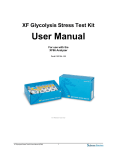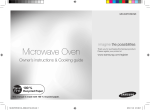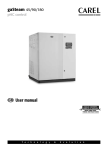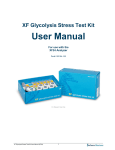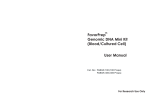Download hplc standard operating procedure
Transcript
University of Kentucky, Biosystems and Agricultural Engineering Dept HPLC STANDARD OPERATING PROCEDURE Aminex 87‐H and 87‐P analytical columns BAE 1/28/2015 BAEHPLCStandardOperatingProcedure:87Hcolumn LastUpdated:12December2014 READ & UNDERSTAND THE ENTIRE SOP BEFORE BEGINNING Note:AnSOPcannotcoveralltheneededinformationforproperinstrumentunderstandingandoperation, orcoverallscenarios;norcananSOPeliminatethenecessityofawareness,attentiontodetailsandmost importantlyactivethinking!Pleaserefertotheinstrumentmanualsfortheneededbackground information,reviewliterature,andalwayskeepthemostpowerfulinstrument,thebrain,turnedon.When indoubtaboutsomething,ask! HPLC System Information 1. Hardware:Dionex‐ThermoFisherUltimate3000w/auto‐sampler(HPLC#2),P‐680pump,TCC‐100 ColumnCompartment,VariableWavelengthDetector(UV);ShodexR01RefractiveIndexdetector 2. Consumables:AnalyticalcolumnBio‐RadAminexHPX‐87H(order#125‐0140)(ionexclusion);Guard columnisaBio‐RadMicro‐GuardCation‐Hcartridge(order#1250129);columntypicallyoperatesat 50°C 3. Thecolumntypeisspecifictotheanalytes.The87Hcolumnisahydrogen‐formcolumnusedfor analysisofcarbohydratesinsolutionwithcarboxylicacids,volatilefattyacids,shortchainfattyacids, alcohols,ketones,andmanyneutralmetabolicby‐products.Mostoftenusedfororganicacidanalysis, thiscolumnisalsousefulforfermentationmonitoring,biologicalfluidanalysis,andacetylatedamino sugarseparations.Seehttp://www.bio‐rad.com/fordetailedinformationonotheranalyticalcolumn chemistryandpurpose. HPLC Operating Procedure A. Mobile Phase (also known as working buffer, buffer, or solvent) 1. Flowrateistypically0.4mL/min,constantflowrate(isocratic),typicallya20‐70minuterun–run timewillbeafunctionoftheelutiontimeoftheanalytesbeingquantified. 2. Mobilephaseis5mMsulfuricacidforthe87Hcolumn.(Fisher#AC124645001) B. Mobile Phase & Flush Water Preparation for the 87H Column 1. Themobilephaseisdefinedbythecolumntype–differentcolumnsmayhaveadifferentmobile phasechemistry. 2. Thevolumeofmobilephase/bufferneededwillbecalculatedbyChromeleonafteryou’vesetupthe run.SeeD.9below.Confirmtheamountneeded,checktheexistingvolumeinthebufferrackon theHPLC,andmakemoreifneeded. 3. Tomakebuffer,preparea500mMstocksolutionofsulfuricacidusingthecertificateofanalysisto definethepurityoftheconcentratedacid.Yourcalculationsshouldyieldamixtureofabout2.8mL ofconcentratedsulfuricacidinto97.2mLofdoubledeionizedwater(DIwater);notethattheDI waterunithasa0.2micronfilterin‐line. 4. Add10mLofthe550mMstocksolutionto990mLof(DIwater)usingaclean,DIwaterrinsed,glass 1Lgraduatedcylindertoyielda5mMfinalconcentration. 5. Vacuumfilterthebufferfromthegraduatedcylinderthrougha0.2µmx47mmnylonfilter(Pall Corporation,order#66602)todegasandcleanbuffer;useaglassfunnel/supportsystem(Pall BAEHPLCStandardOperatingProcedure:87Hcolumn LastUpdated:12December2014 Corporation,order#4013or#4012).Storefilteredbufferintoanappropriatecontainer(1,2or4L glassbottlewith33mmthreadedtop) 6. Thepurityofthebufferandflushwateriscritical–donotskipthefiltrationstep.Poorlyprepared, contaminatedbuffercandestroyaguardcolumn,and/ortheanalyticalcolumn. 7. Theworkingbufferandflushwatercanbedegassedifdesired;however,theHPLChasade‐gassing pumpsomanualde‐gassingisnotneeded. 8. ClearlyLABELallsolutionbottleswiththechemicalcompositionofthecontents,thedateprepared, andthenameofthepreparer. 9. Dionexrecommendsreplacingaqueoussolventsatleasteverytwoweeks.Donot‘topoff’solvent bottlesduetopotentialbuildupofunwantedcomponents.Donotletsolventbottlesrundry!Ifa solventbottlelookslikeitwillbeemptybeforetheanalysisiscomplete,stoptherunbetween samples;seesectionD.1fortherequirementstochangesolventbottles. C. Standards & Standard Curves NOTE:Standardcurvesaredevelopedbytheoperatorusingcalibrationstandardsandareusedbythe HPLCsoftwaretoquantifytheconcentrationofanalyteinthesample;thestandardsallowtheoperator toestablishtheelutiontimeofanalytes,andaccountforcolumndriftorshiftingelutiontimesduring analysis(anormaloccurrence).CalibrationstandardsMUSTbeusedwitheveryHPLCanalysisevent. 1. Calibrationstandards(preparedsampleswithknownconcentrationsusedtocalibratethe instrument)shallbepreparedaheadoftimeforeachanalyteofinterest.Thecalibrationstandards preparedforeachanalyteshallincludenotlessthanatwo(2)lowendconcentrations,two(2) differentmid‐rangeconcentrations,andahighendconcentrationforatotaloffive;thisrangeof concentrationvaluesshouldbrackettheexpectedrangeofconcentrationsinthesample.Typically, theconcentrationsshouldbefrom70%ofthelowestto130%ofthehighestexpectedinthe sample;notethatblanks(zeroes)donothaveapeak.Astartingpointtodeveloptheappropriate standardconcentrationswouldbetouseliteraturevaluesfrommultiplesourcestoestablishthe bracketingconcentrationswithmultiplepointsaroundthetypicalconcentrationsreported.Askthe HPLCoperatorabouttheinstrumentdetectionlimit(s)foryouranalytes.Note:theconcentrations neededforthecalibrationsampleswilllikelybedifferentforeachanalyte. 2. Thecalibrationisvalidonlywithintheconcentrationrangeofthestandardsusedandnotbeyondit; thussamplesthatareoutsidetherangeofconcentrationsinthestandardswillproduceunreliable results.Agoodunderstandingofthecalibrationprocess,linearregression,andstatisticsisofgreat value‐seethe“TheoryofCalibration”inChromeleon6.80UserManual,startingonpage109.The manualisfoundonthereferencelibraryCD(D:\library\manuals\software\CM_680_V30.pdf) 3. Combiningmultipleanalytesintoasinglestandardvialisacceptable,providedthatthereisgood separationbetweenpeaks;ifindoubt,makeseparatecalibrationsamples.Ensureconcentration calculationsarecorrect–usetheCertificateofAnalysis(CoA)concentrationsfortheactualsource bottleratherthanthenominalconcentrationprintedonthelabel.IftheCoAconcentrationisnot onthesourcebottle,itcanusuallybefoundonthesupplier’swebsite–usetheLotNumberand catalognumberprintedonthelabelassearchparameters. 4. Allofthecalibrationstandardsshallberunatthebeginning,andthenunknownsamples;providea blank,aspikedsample,andaduplicateunknownsampleforeachrun,orforevery15to17 unknownsamples.Thethreeextrasamplesareusedforqualitycontrol(QC);these18to20 BAEHPLCStandardOperatingProcedure:87Hcolumn LastUpdated:12December2014 samplesrepresentagroupofsamples–theunknownsplusthequalitycontrolsamples.Theblank willbeasamplethatincludesthebackgroundmatrix,i.e.,anyreagentsusedinsamplepreparation, freshmicrobialmedia,etc.,butdoesnotcontaintheanalytesofinterest[theblankprovidesa chromatogramofthebackgroundmatrix].Thespikedsampleshouldbepreparedbysplittingan existingunknownsampleandthenaddingaknownquantityofeachanalytetothesample[the spikewillshowthebackgroundmatrixeffectontheanalytes,ifanyexists].Theduplicatesampleis asplitunknownsamplethatcancomefromanyunknown–itisoftentakenfromthesamesample thatusedinthespikingprocess[theduplicatewillshowinstrumentvariability].Thequality controlsamplesshallbeevenlyspacedamongtheunknownsamplessothattheQCcheckoccurs throughoutthegrouping. 5. Provideatleastonecalibrationverificationsamplepergrouportwoperrun.Acalibration verificationsampleisapreviouslyinjectedcalibrationstandardthatisinjectedagaintocheckthe accuracyandrepeatabilityofthecalibrationandanalyticalresults.Thesamplemustbedesignated asa“validationsample”inthe“type”columnwhensettingupthesequencerun–seeD.1.8. 6. Runnotlessthanonestandardfromeachanalytegroupseveraltimesduringtheruninorderto determineifthepeakisshiftingintimeandtoprovideadditionalcalibrationpointsorcalibration verificationpoints.Itisgoodpracticetoincludemoreinjectionsofthelowendcalibration standardstoprovideanaveragecalibrationpointandsome“weight”tobalancetheinfluenceofthe higherconcentrations[seeitem2aboutthenecessityofunderstandingthecalibration(regression) process]. 7. TheFIRSTcalibrationstandardinjectionisa“waste”(thesystemusesthisfirstinjectionaspriming forthecolumnsoitneverisasgoodassubsequentinjections);useanyofcalibrationstandards becauseitwillnotbeincorporatedintothestandardcurve.ThesequencecouldbeS2,S1,S2,S3, S4,andsoon,wherethefirstS2injectionisthe“waste”injection.Thenextthreeormoreinjections shallbestandardsloadedinorderofincreasingconcentration. 8. Onestandardfromeachconcentrationgroupingshallberunafterthelastsampleattheendofthe run.Thetotalnumberofcalibrationstandards,verificationsamples,QCsamples,andunknown sampleshastobeconsideredtodeterminetheneededbuffervolume–Chromeleonwillcalculate theneededvolumeafterthesequencehasbeensetup. 9. Foreachgroupofunknownsamplestobeanalyzed,randomlyselectnotlessthanthreebutnot morethan10samplesandanalyzeusingthepreviouslyselectedstandards.Reviewthe chromatogramstoensurethatthecorrectanalytes[allthepeaksfromtheunknownsamplesare accountedfor]andcorrectcalibrationstandardconcentrationshavebeenchosen[alltheunknown sampleconcentrationsliewithinthecalibrationstandardconcentrations];adjustasneededbefore analyzingtheremainingsamples. 10. Thebestpracticeistoinjectthesmallestamountpossibleforbothstandardsandunknown samples;itissuggestedtostartat20microlitersandincreasefromthereifthereisnotasufficient response–usetheinjectionsdescribedinC.9toassesstheresponseofagivenconcentrationand injectionvolume–adjustasrequired. 11. Theinjectionvolumewilldeterminehowmuchsample/standardvolumeshouldbeinthevial,e.g.a 100μlinjectionmusthave600μlinthevial.Typically,theHPLCsamplevialscontainatleastone mL.Iftheavailablesamplevolumeislimited,thereareinserts(250ultotalvolume)thatfitinside thestandardvials.Ifyou’reusinganinsert,adjusttheinjectionvolumeonthesamplesetuppagein theHPLCsoftware,andchangeneedleheight.Failuretoadjustthesoftwaresettingforneedle BAEHPLCStandardOperatingProcedure:87Hcolumn LastUpdated:12December2014 heightforvialswithinsertswillresultinbrokeninsertsand/orneedlessincetheneedlegoestothe bottomofthevialwhenextractingthesample. D. Instrument Preparation & Sample Analysis NOTES: a. Thefollowingscreenshotsareintheappropriateorderofoperations–NoShortcuts!Themobile phasemustbeflowingbeforeheatingthecolumnorwarmingtheUVlamp. b. TheUVdetectorisnotneededwhenanalyzingonlycarbohydrates(sugars)onthe87H c. BoththeUV&RIdetectorsshallbeusedforfermentationanalyses d. RefertotheChromeleonsoftwaremanualfordetailedinformationoncreatingnewinstrument methodsandprocessingmethods I. Getting Started 1. Open Chromeleon usingthetoolbar Icon.Itwillopen tothisscreen: 2. Selectthe instrumenttabin thelowerleft corner,select UNIVERSITYOFKE N_1intheleft pane,andselect theHometabfor generalstatus. BAEHPLCStandardOperatingProcedure:87Hcolumn LastUpdated:12December2014 3. Onthepump moduletab,you canensurethat thepumpis connected,setthe flowrate,choose themobilephase bottle,turnthe pumpon/off,and startapurgeto setupanew solventbottle. a. Topurgethelinesofairafterinstallinga newbottleofmobilephase(airinthelines isBAD),openthepumpmoduledoorand turntheknurledbrassknobtwofullturns (thisbypassesthecolumnandsendsthe flowdirectlytothewastecontainer). b. Thenputacheckinthepurgeboxandthiswindow willpopup.Startthepurge–thepurgeprocess hasabuiltintimer.Ifthereisstillvisibleairinthe lines,purgeasecondtime.Oncethetimerhas elapsed,thepurgebuttonwillgofromgreenback togray.BesuretoCLOSETHEPURGEVALVE! BAEHPLCStandardOperatingProcedure:87Hcolumn LastUpdated:12December2014 c. Nowstartinitialflowthroughthecolumntopreparethesystem i. Checkthemotoronbox–itwillturngreen ii. Settheflowrateat0.1mL/minandletitflowfor30minutes–thesystempressure shouldbestableafter30minutes–ifnot,continueflowat0.1mLuntilpressureisstable. iii. Settheflowrateat0.2mL/minfornotlessthan15minutes(thisensuresthatthecolumn isfullbeforeheatingbegins) 4. Gotothecolumntab, adjustthedesired temperaturesetpoint andturnon “Temperature”.After thecolumnreaches thetemperatureset point,increasethe flowin0.100mL increments,wait15‐ 20minutes,and repeat(increaseflow rate,wait15‐20min) uptothefinaldesired flowrate. 5. GototheRITaband checkthepurgebox; purgefornotlessthan 5minutestoremove air,differentsolvents, etc.UNCHECKTHE PURGEBOXBEFORE STARTINGTHE SAMPLERUN SEQUENCE! BAEHPLCStandardOperatingProcedure:87Hcolumn LastUpdated:12December2014 6. IfusingtheUV detector,gototheUV tabandsetthedesired wavelengthvaluein oneofthe4channels ,i.e.,UV1toUV4(the channelusedis specifiedinthe instrumentmethod usedinasequence). TurnontheUVlamp; itwilltakeatleast30 minutesforthelamp towarmup–system willnotproceedwith therununtilthelamphasreachedoperatingtemperature. 7. Gotothesampletab. Usethedefaulttray controlsettingsfor eachcolor(thecolors representsectionsof thetray).Setthetray temperaturetothe appropriatesetting foryoursamples,e.g., 8°Cistypical, however4°maybe appropriatefor sampleswith microbes,orhigherif needed.Usethe “startup”and“inject”defaultvalues.Theinjectionvolumevalue(seeC.9above)willbeoverwritten bythevalueusedinthesequencewrittenforyoursamples. BAEHPLCStandardOperatingProcedure:87Hcolumn LastUpdated:12December2014 8. Nowthatthe instrumentisready, youcancreateanew sequenceoropenan existingsequencefile fromthedatapane thathasthesametype ofsamplesasyours andexecutingasave as“YYYYMMDD_file descriptor”,e.g. “20140613_JohnDoe_F ermentation”.Fora newsequence,you Changethevaluesin “name,type,and position”columnstomatchyoursamples.Usetheappropriateinjectionvolume(C.9above).Usethe existinginstrumentandprocessingmethodsunlessyou’vecreatednewones.WhenusingtheUV, opentheinstrumentmethodandconfirmthatthechannel&wavelengtharewhatyouwant.Select the“start”dropdownmenuandselect“addsequencetothequeue”. 9. Gotothequeuetaband selectthe“readycheck” intherightpane.The readycheckwill calculatetheneeded mobilephase(a.k.a buffer,solvent)volume neededanddisplayat thebottomofthe windowontheright side.Ensurethatthere ismorebufferinthe bottlethanthe calculatedvolume;ifnot seeB.2–B.9;oncethe buffervolumesupplyisconfirmedthenclickthestartbutton.Therunwillstoponitsownonce completeandusethe“Smartshutdown”thatisalreadyprogrammed.Removethesamplesand disposeofthevialsintheproperlocation. 10. Ifthereareerrorsduringyourrun,consultwiththeHPLCoperator,astheactionsrequireddepend onthenatureoftheproblem.Aftertheerrorisresolved,youcanopenthesequence,changethelast samplefrom“interrupted”to“idle”andthensavethesequence.Beforerestartingtherun: a. Gototheconsole,samplertab,selectthewashbufferloopbutton.Thiswillcleantheflowpath toensurethereisnocrosssamplecontamination.Oncethewashiscomplete(thewashbuffer BAEHPLCStandardOperatingProcedure:87Hcolumn LastUpdated:12December2014 loopbuttonwillchangebacktogray),restarttheflowrateat100uLandfollowtheflowrate incrementalincreaseprocessdiscussedaboveinD.1.4.Oncetheflowrateisbacktothedesired value,restartthesequence. II. Results Quality Control & Data Archival NOTE:Theareaunderthecurveofeachpeakisusedwiththestandardcurvetogeneratea concentrationvalue.Thus,anyerrorinareadelineationonthechromatogramand/orcalculation directlyandsignificantlyimpactstheresults. 1. StandardCurves(calibrationcurves)shallbedevelopedfromthestandardsforeachindividualrun –donotre‐usestandardcurves.ThedefaultregressionoptionsinChromeleonMUSTbereviewed foreachanalysiseventtoensurethechosenregressionoptionsmakesense.Thetypicalsettings wouldbe“linearwithoffset”,“averagingallresponsevaluesforeachcalibrationlevelbeforecurve fitting”,and“noweighting”.IfanyregressioncurvehasanR‐squaredvalueoflessthan0.999, investigatetheproblemandrepeattheprocesstoachieveanacceptableregression.Seethe Chromeleon6.80UserManual,startingonpage109.Themanualisfoundonthereferencelibrary CD(D:\library\manuals\software\CM_680_V30.pdf)itprovidesexcellentbackgroundinformation oncalibration. 2. Chromeleon’sautomatedtoolcanbeusedtoestablishbaselinesforeachpeak,identifythepeak, andthedroplinesforadjacentpeaks.However,thesoftwareisonlyastartingpoint–the chromatogramforeachsampleshallbereviewedmanuallyandcorrectedtoensuretheproper placementofthelinesdefiningthepeak’sarealboundary–theareadefinitioniscriticaland requiresintensefocus. 3. Thearealboundarylines(baselinesanddroplines)maybedefinedmanuallyusingtheHPLC software,theareavaluesexportedtoexcel,regressed,andconcentrationscalculatedwithoutusing theChromeleonalgorithms. 4. Thedata(chromatogramfile)fromeverysampleanalysiseventMUSTbearchivedinMSexcel formatonastoragedeviceotherthanthecomputeroperatingtheHPLC.Thedatashallbeexported onaweeklybasisorasneeded(suchaspriortoaHPLCsoftwareupdate).Thedatainthearchive MUSTbemaintainedforaperiodof10yearsfromtheanalysisdate.Thedatashallbearchivedin primaryfoldersbyexperimenter’sname,then(years)andsecondaryfolders(months).TheMS Excelfilesshallincludeaprimaryidentifierinthename,sotheanalysistypecanbereadily identified.Thedocumentpropertiesdialogboxisaconvenientplacetoutilizekeywords,etc.,to facilitateasearchfunctionwithinthearchive. E. ROUTINE INSTRUMENT MAINTANENCE Note:Refertotheequipmentmanualsforin‐depthmaintenancerequirementsincludingroutineand periodicmaintenancefortheinstrumentsandanalyticalcolumns.SeetheattachedBio‐RadUse&Care guideforbothanalyticalandguardcolumns(BRUC). I. HPLC Operation & Maintenance Logbook 1. AlogbookshallbemaintainedbytheoperatorforeachHPLCsystem. 2. Thelogbookwillbestoredateachinstrument’slocationandwillbeavailableforinspection 3. Thelogbookentriesshallincludetheinitialsofthepersonmakingtheentry,date,time,andnotes regardingcolumn(guard&analytical)maintenance,replacement,andperformance,aswellas BAEHPLCStandardOperatingProcedure:87Hcolumn LastUpdated:12December2014 pertinentinformationaboutthesamplesbeinganalyzed,alongwithsystemperformance.Allcalls toDionexandBio‐Radtechnicalsupportshallalsobedetailedinthelog. II. Guard & Analytical Columns Note:Theguardcolumnmaintenanceandreplacementfrequencydependsonthesamplesbeing analyzedandthuscannotbepredicted.Ingeneral,replacementiswarrantedwhenstandardsamples illustrateachangeinthemeasureddata(resolution) 1. Allcolumnprocedures(installation,start‐up,&maintenance)shallbedonepertheBRUC. 2. Anewguardcolumnshallbeinstalledwhenanewanalyticalcolumnisinstalled. 3. Thetotalsystem,analytical,andguardcolumnpressuresshallbedeterminedatnormalflowrates whennewlyinstalledandrecordedinthelogbook.RefertotheBRUCfortheprocedureto determinecomponentpressuresfromsystempressures. 4. Beforeanysamplesareanalyzed,allnewlyinstalledcolumnsshallbetestedandtheresults comparedtothefactorysuppliedchromatogramtoensurepropercolumnandsystemperformance. Oncethesuppliedandproducedchromatogramsmatch,samplesanalysiscanbegin.Boththe supplier‐producedandinvestigator‐producedchromatographsshouldbedatedandtapedintothe logbook. 5. TheHPLCpressurelimitcontrol(aoperatingsoftwaresetting)shallbesetsothatapressure increaseof15%greaterthanthepressurefoundin#3(operatingpressure)shallcausethepumps tostop. 6. Theguardcolumnshallbereplacedifitspressureisgreaterthan150%ofthepressurewhennew. 7. Withahighpressureshutdown,aflush®enerationcyclewiththeproperregenerationsolvent shallbecompletedontheanalyticalcolumn.SeetheBRUCtable#2forspecificsand troubleshooting. 8. TheSystemwillneedtohavebufferrunthroughitfornotlessthan½houronceaweek(ifcolumn isinplace)whenidlealongwithflushingpumplinewithddwater. 9. Agradualincreaseincolumnpressureisnormalasthecolumnagesandisproportionaltothe numberofinjections. 10. Lessonslearnedregardingcolumnlife&performanceshallbeincorporatedtothisSOPbythe operator. F. SOP MAINTANENCE 1. TheHPLCoperatorshallreviewthisstandardoperatingprocedureevery6monthsandmakeall neededchanges,andrevisethedateofupdate. 2. Dionex&Bio‐Radtechnicalsupportsolutionstospecificproblemsshallbeincorporatedintothe SOP. 3. BestpracticeslearnedbytheHPLCoperatorforsamplepreparation,standards,standardranges, etc.,shallbecommunicatedbytheoperatortothe“owner”oftheSOPforincorporationintothe appropriateSOP.












